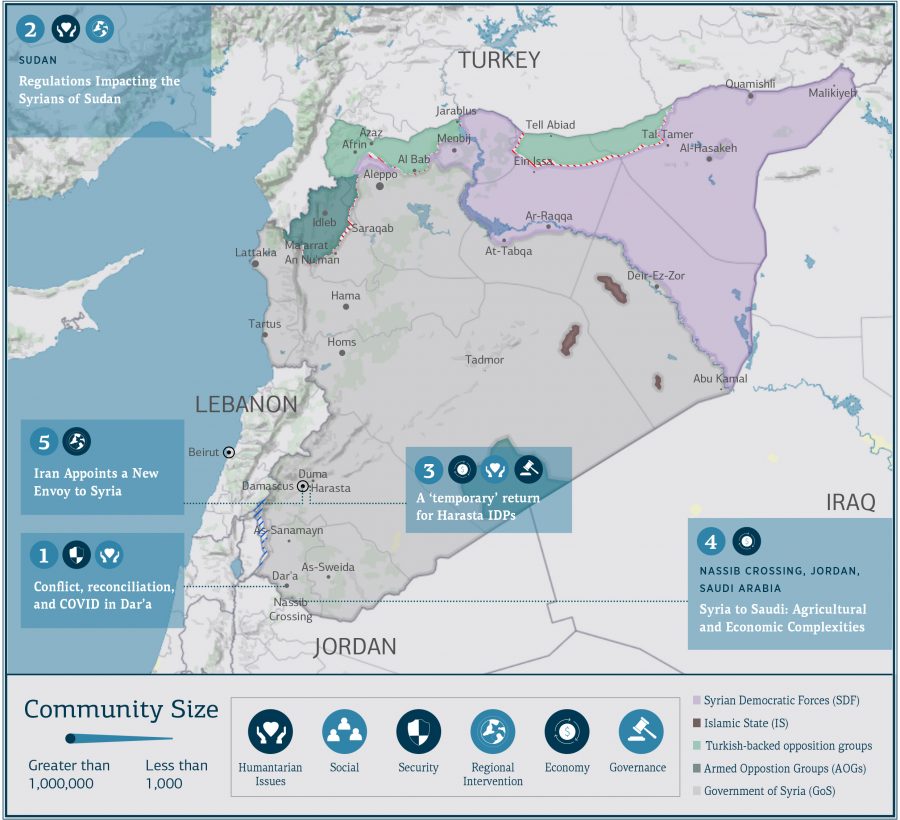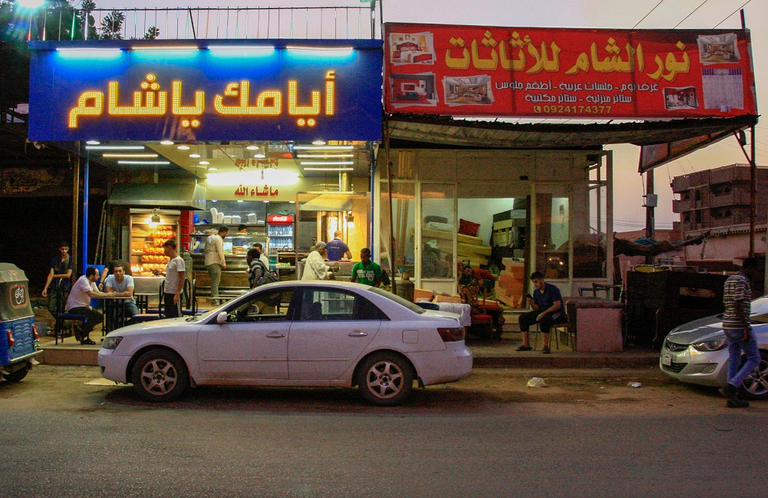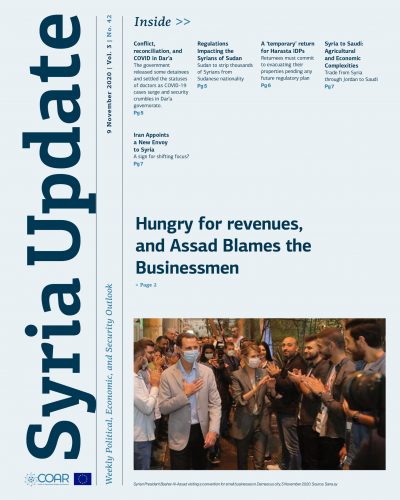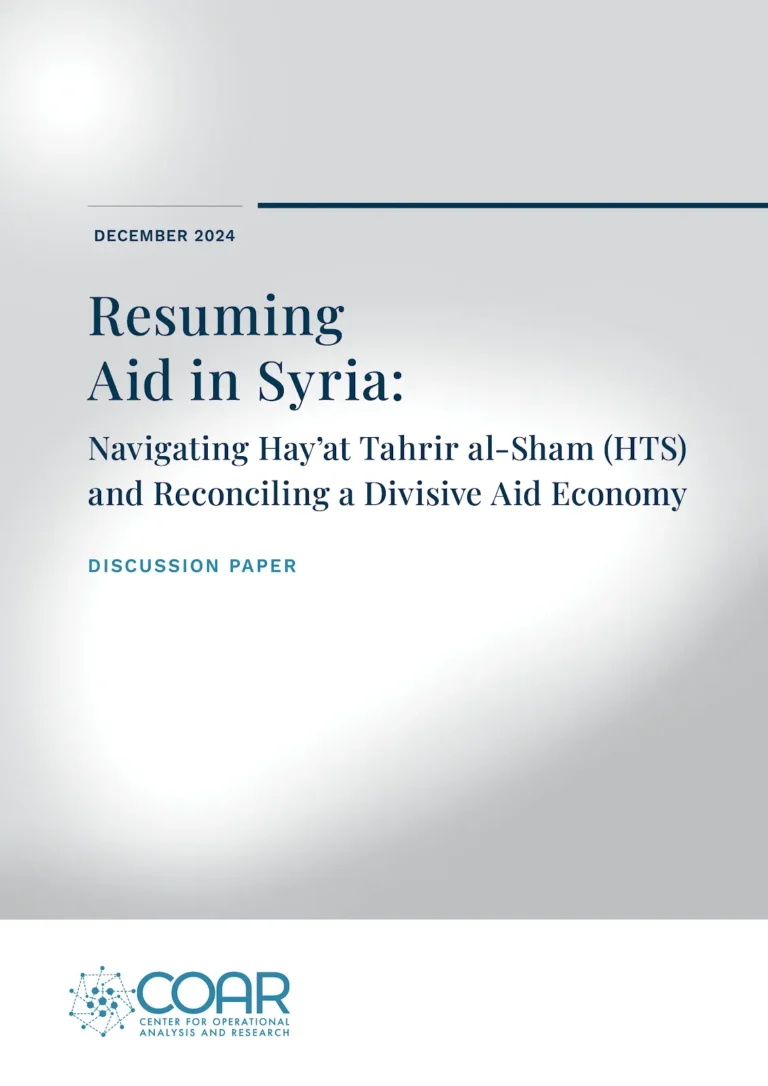Syria Update
9 November 2020
Hungry for revenues, and Assad Blames the Businessmen
In Depth Analysis
Over the past week, the Syrian parliament has continued to discuss the government proposed budget for 2021, outlining new revenue streams and limits on spending. The Government of Syria also made a number of policy changes since late September in order to help finance its budget commitments. Current expenditure is expected to increase by 159 percent to 7 trillion SYP ($2.75 billion at $1 = 2,540 SYP) in 2021, forming close to 82 percent of total spending. Skepticism has traditionally accompanied government budget plans, and in addition to large, almost fictional deficits, the government is planning revenues that significantly overlook reality.
Give me your money, or fight for me
On 3 November, Syria’s Finance Minister, Kinan Yaghi, announced support for a new policy allowing Syrians in the country to pay waivers in lieu of military conscription. Only those deemed unfit for field operations would qualify. This service was previously only available to Syrians abroad at the cost of $8,000. While aimed at increasing government revenues, few Syrians can afford the fee, as most people struggle with basic necessities. Military conscription will, therefore, remain an unpleasant reality for most of Syria’s predominantly poor young people. Yet it should be noted that the imposition of heavy fees on bureaucratic services is not unprecedented. Since 2017, embassies have charged Syrians between $400-$800 for passports issued outside Syria (See: Syria Update 19 October 2020) — by far the most expensive passport in the world.
Symbolic measures vs. inflation
With several crises debilitating its economy, the government’s pledges in 2021 clearly prioritize spending on social support, including subsidies on wheat and oil products, and small and medium sized industries (See: Syria Update 5 October 2020). However, though an important and symbolic measure, there is little evidence that the government’s spending plans could fend off high inflation. Since the start of the year, the prices of subsidized food and oil products have increased by up to 140 percent, further inflating all goods and services. The price of petrol in Syria today is almost twice that of Lebanon and Turkey.
The government’s spending plan reiterates its symbolic commitment to public sector salaries and it announced several measures supporting salaried workers. The most recent of these was on 4 November, granting “administrative burden compensation” to employees in the Ministry of Education and the Ministry of Higher Education — the two largest state employers (excluding the Ministry of Defense). The increase ranged between $0.3-$40, depending on rank and duties. Like previous salary increments, the real value of these adjustments decreases as the currency falls, and prices increase. The cost of living in Damascus today is close to 660,000 SYP per monthly.
Assad: Blame the businessmen
In an appearance on local media channels, Syrian President Bashar Al-Assad blamed Syria’s economic turmoil on Syrian business people who had lost access to foreign currency deposits in Lebanese banks. At a convention for small businesses in Damascus, Al-Assad stated that Syria’s economic crisis is not caused by economic sanctions, but rather by the ongoing economic crisis in Lebanon and the loss of “between $20-42 billion” deposited by Syria’s business community.
Indeed, Syria is undergoing a multivariate crisis, triggered by sanctions, Lebanon’s current turmoil, and the ongoing global economic shock caused by COVID-19. However, Al-Assad appeared eager to divert popular discontent away from the state and onto the business class, stating: “it is easy to blame the state, but that’s not the essence of the problem”. Notably, the collapse of the Lebanese banking sector has locked away foreign currency deposits used by Syrian businesses to pay for imports, immensely restricting efforts to keep its currency afloat and ensure the availability and affordability of goods and services in the domestic market.
The government’s proposed measures seek to expand its domestic revenue sources, giving little back to the populace beyond symbolic gestures and statements. Social safety nets, including employment and remittances, have already worn thin, and the crumbling government has little willingness and ability to maintain social support pledges. On top of that, Syrians are being asked to dig deeper to secure minor privileges, with no guarantees it will improve living conditions. As the state continues to crumble, international development actors could exploit Al-Assad’s symbolic gestures to generate short term gains for ethical development in Syria. Small businesses, for instance, are a potential entry point for broader development programming. This approach, however, requires readiness from international actors to act in a coordinated and strategic manner and thus to exert collective leverage and advance their respective objectives.
Whole of Syria Review

1. Conflict, reconciliation, and COVID in Dar’a
Dar’a city, Dar’a governorate: On 4 November, the Government of Syria released 62 detainees in a public ceremony at the Dar’a governorate headquarters. Notable government security figures were present, including Hussam Luka, the head of the security committee in Dar’a and the head of Syria’s General Intelligence Directorate. On the same date, Luka stated 774 individuals in Dar’a governorate had their security statuses settled, among which were 32 doctors able to resume their practices. State-affiliated media cited the July 2018 reconciliation agreement as to the reason for the release. However, bar a few exceptions, most of the freed were detained after the reconciliation agreement in Dar‘a. Notably, the timing of the release comes amid a significant increase in COVID-19 cases in the governorate, as well as a surge in security incidents — explosions and demonstrations following the assassination of government interlocutor Adham Al-Krad and other members of Dar’a’s Central Negotiation Committee on 14 October (see: Syria Update 19 October).
Limited release equals limited impact
The disruption following Al-Krad’s assassination has compounded ongoing concerns over local stability. Protests have featured rising calls for the fall of the regime and more concerted attention to the demands of reconciled communities in their negotiations with the Syrian government, particularly over detainee releases. Indeed, it is striking that Al-Krad was killed during a return trip from Damascus, where he had reportedly been discussing the release of Dar’a-based detainees with government officials. Several thousand people have reportedly been arrested in Dar’a since the beginning of the conflict, and securing their release or establishing their whereabouts has been at the forefront of community concerns during the post-reconciliation period.
As such, this latest prisoner release is likely intended to at least partially stifle related community anger from Al-Krad’s killing, but its effect is likely to be both minimal and temporary. Not only were all those released reportedly detained at some point after reconciliation agreements were reached in 2018, but they also represent a fraction of the thousands whose status remains unknown.
Give me your doctors
In relation to the status settlement, it is not coincidental that some of those settled this week are doctors. Notably, reconciliation agreements in Dar’a did not previously allow health care workers to resume their practices, as opposed to other public employees, including teachers (See: What Remains?: A Postmortem Analysis of the Cross-Border Response in Dar’a). The settlement of doctors comes amidst a significant increase in COVID-19 cases in Dar’a governorate (unspecified) and in Zaatari and Azraq refugee camps on the Syrian-Jordan borders (509 cases). Notably, the governorate’s health directorate in Dar’a does not publish the numbers of infected people or the number of deaths as a result of COVID-19.
Despite minor infrastructural improvements, reports from Dar’a reference acute shortages of medical staff and specialists, severely undermining health access as concerns over COVID-19 rise. Indeed, Dar’a’s fragile health system is among the most badly affected by Syria’s conflict, especially on account of a significant escalation in violence that occurred in 2018 in the lead up to its reconciliation. Though any additional support to health services should be welcomed, it is likely that the move will be regarded with understandable cynicism. Syria’s health sector generally, and Dar’a specifically, suffers from ongoing structural and operational hindrances, as well as from the government counterproductive security-focused COVID-19 strategy. Thus, while useful, increasing the number of health care workers will not necessarily solve debilitating structural deficiencies in the health sector, consequently falling short of local needs.
2. Regulations Impacting the Syrians of Sudan
Sudan: On 1 November, media sources reported that Sudan’s transitional government had stripped 13,000 foreigners of Sudanese citizenship, including at least 10,000 Syrians. In its statement, the Sudanese government stated that the decision would include all foreigners who obtained citizenship illegitimately, while requesting all those who obtained citizenship between 2014 and 2019 to visit the Passports and Migration Department within two weeks to prove the validity of their nationalizing procedures.

Stranded in Africa
The recent Sudanese decision is embroiled within Sudan’s own domestic quandaries as it tries to rebuild its international reputation after having been removed from the U.S. list of State Sponsors of Terrorism, and as it relaunches its economy. Stripping foreigners of their citizenship is likely a response to both these issues. Those targeted by the move are likely seen as allies and remnants of the former regime, and as influencing various sectors of the Sudanese economy that trigger anti-foreigner sentiments and popular discontent. Thus, as Sudan struggles to realign itself on the diplomatic stage and stabilize its economy, targeting this segment of the population could be perceived as an easy win.
That said, most Syrians in Sudan arrived after the conflict began in 2011. By August 2019, at least 100,000 Syrian refugees were reported as living permanently in the country, where entry and residence requirements were the most permissive in the region. Sudanese documentation also facilitates Syrians’ mobility, especially in Gulf states. However, restrictions began to increase after the ousting of the Al-Bashir-led regime in 2018. It is yet to be seen whether the recent measures will affect all Syrians residing in Sudan, or if it will lead to deportations, but the motivation for the measure could be a warning. Furthermore, those stripped of their Sudanese citizenship will face the unenviable challenge of acquiring a Syrian passport, potential deportation, and/or repatriation.
3. A ‘temporary’ return for Harasta IDPs
Harasta, Rural Damascus. On 1 November, the Rural Damascus Governorate Council imposed new conditions on IDPs willing to return to their houses in Harasta, Eastern Ghouta. The measure applies only to partially-damaged properties; conditions include providing proof of ownership and, surprisingly, a signed pledge to evacuate their properties were future regulatory plans implemented. Just under 40 households are expected to return under these conditions. In the adjacent neighborhoods of Qaboun and Jober, security forces continued to prohibit IDP returns, opposing a decision by the Rural Damascus Governorate Council made on 28 October. As of 8 November, systematic demolition activities of buildings continued in these neighborhoods, often citing the lack of structural safety.
Come back, but your houses are mine
Urban development plans have added to a long list of nightmares for Syrians originating from former opposition-held areas. In addition to the many security concerns, levels of destruction, and deteriorating living conditions, residents and IDPs from former opposition-held areas, especially around Damascus, also worry whether a new urban development plan will deprive them of their homes. For many, these properties are the last resort of a rapidly-thinning safety net. While the Rural Damascus Governorate’s decision permitted a few people to return, they are not safe from displacement yet again. The temporary return permitted by the government is likely a result of its own economic turmoil, suffering unprecedented shortages in resources. For returnees today, even after undergoing exhaustive security checks, bureaucratic red tape, and bearing the cost of rehabilitating their houses, there are no guarantees for their safety, nor can they foresee when a future eviction may occur.
4. Syria to Saudi: Agricultural and Economic Complexities
Nasib Crossing, Jordan, Saudi Arabia: On 3 November, hundreds of cargo trucks, loaded with Syrian fruits and vegetables, were reportedly blocked at the Syrian-Jordanian border. The source attributed this to restrictions by Jordanian authorities, allowing only 30 trucks a day to cross on the Nasib-Jaber crossing. Notably, on 31 October, news sources indicated that the crossing was the subject of recent discussions between the Russian delegation and Jordan authorities, specifically concerning its vital role in trade through Jordan with the Gulf states. Furthermore, it is rumored that the leader of the Russian-affiliated Fifth Corps, Ahmad Al-Odeh, could assume control of the crossing. While also citing terrorism concerns, the recent changes at the crossing could provide Al-Odeh and other Russian-affiliated groups in the area with significant influence and resources.
Hungry for food, poor for trade
Responding to the rising demand for agricultural products in Gulf states will likely cause upward pressures on prices, and downward pressure on goods available in local markets. There are always winners and losers in trade. If the recent changes at the Nasib-Jaber border crossing translate into increased demand for Syrian goods, traders and farmers will be more inclined to sell to the Gulf states as the Syrian consumer base has becomes increasingly impoverished, with few resources to compete. Such trends are already visible after Saudi Arabia resumed the issuance of access permits for Syrian trucks in September. That said, the pressures of resuming trade with the Gulf might be eased if long waiting periods at the Jordanian borders persist, as the short shelf life of agricultural products may disincentivize rapid surges in trade.
5. Iran Appoints a New Envoy to Syria
Damascus: On 22 October, a ceremony was held in Damascus to welcome the appointment of Hamid Saffar Harandi as the new Representative of the Iranian Supreme Leader to Syria, replacing Ayatollah Abolfazl Tabatabaei Ashkezari. The ceremony was attended by Iran’s ambassador to Syria and representatives of the two governments. During the ceremony, Harandi called for “bolstering the unity and brotherhood between the Syrian and Iranian people.”
All the Mullah’s men
It is unlikely that Harandi, now Iran’s top envoy to Damascus, will bring about a major shift to Iran’s strategy in Syria. As the trusted representative of Tehran’s highest authorities, his arrival will likely bring with it more of the same. However, it is noteworthy that Harandi’s previous tenure involved managing Iran’s cultural engagement projects in South Africa and other African countries. Harandi also headed the Al-Mustafa International University, located in Qom province, Iran’s most influential cultural hub. With no clear military or regional expertise, Harandi’s prior cultural role both inside Iran and abroad highlights the subtle contours of Tehran’s approach to Syria. While Iran has not placed its thumb on the scale in Syria with the same direct military might as Russia, its cultural presence on the ground is significantly more diffuse, widespread, and likely permanent. In Syria, soft power follows hard. The outgrowth of Russian- and Turkish-language programs is ready evidence of this. However, Iran has attained a religious prestige — and a degree of military and cultural affinity — that will make it a force to be reckoned with, irrespective of the shape of the conflict itself.
Key Readings
The Open Source Annex highlights key media reports, research, and primary documents that are not examined in the Syria Update. For a continuously updated collection of such records, searchable by geography, theme, and conflict actor, and curated to meet the needs of decision-makers, please see COAR’s comprehensive online search platform, Alexandrina, at the link below.
Note: These records are solely the responsibility of their creators. COAR does not necessarily endorse — or confirm — the viewpoints expressed by these sources.
Trump and Biden do not differ much on the Syrian file
What Does It Say? The U.S. approach to Syria under Trump and Biden is similar in almost every way, bar their approach to humanitarian relief.
Reading Between the Lines: While the expectation is for things to stay the same, the change in government still exposes a degree of uncertainty for the future of Syrians.
Source: Asharq Al-Awsat
Language: Arabic
Date: 28 October 2020
Inside the childhood hunger ‘emergency’ in Syria’s Idlib
What Does It Say? Hunger is on the rise in Idleb, with many children suffering from malnutrition.
Reading Between the Lines: Sanctions, as well as large numbers of displaced people in Idleb, have brought on an increasing scarcity of food, causing prices to rise and many people to go hungry.
Source: The New Humanitarian
Language: English
Date: 28 October 2020
What Does It Say? The red lines of what was permissible when dealing with the Syrian government before 2011 has changed considerably.
Reading Between the Lines: Before 2011, Syrians understood how to navigate between what was socially and politically accepted outside of government reproach. However, over time, red lines have shifted, leaving less room to censure the Government of Syria.
Source: Carnegie
Language: Arabic
Date: 26 October 2020
“We want to live” .. Renewed calls for demonstrations in Sweida on Sunday
What Does It Say? There have been calls for a peaceful demonstration in As-Sweida governorate to protest rising prices and deteriorating living conditions.
Reading Between the Lines: Economic conditions are likely to worsen, leading to more protests down the line.
Source: Enab Baladi
Language: Arabic
Date: 31 October 2020
Stay and Starve, or Leave and Die
What Does It Say? Many Syrian refugees in Jordan are being escorted to the Rukban Camp in the U.S. controlled deconfliction zone.
Reading Between the Lines: The Rukban camp is notorious for its dire humanitarian conditions. Syrians living there are left only the choice between continued hardship in the camp or the dangers outside of it.
Source: Foreign Policy
Language: English
Date: 26 October 2020
Navigating Humanitarian Exceptions to Sanctions Against Syria
What Does It Say? The economic situation in Syria is rapidly deteriorating from 10 years of war, coupled with increasing comprehensive sanctions.
Reading Between the Lines: Sanctions are causing humanitarian organizations difficulty implementing projects despite their exemption.
Source: The Carter Center
Language: English
Date: October 2020
Turkish points rental contracts are legally incomplete and the landowners are claiming dues
What Does It Say? Many landlords have been claiming rents due from Turkish and Turkish-backed groups; however, many have not been receiving their payments.
Reading Between the Lines: Not only have many of these groups occupied areas rent-free, but some have also caused irreversible damage to agricultural land without due compensation.
Source: Focus Aleppo
Language: Arabic
Date: 2 November 2020
The former US ambassador shows the differences between Biden and Trump regarding Syria
What Does It Say? While mostly similar, there are a few distinctions between the Biden and Trump administrations’ approach to Syria.
Reading Between the Lines: Despite minor differences, both scenarios will see U.S. forces remain on Syrian soil.
Source: Damascus MS
Language: Arabic
Date: 5 November 2020
US Envoy to Syria: ‘No change in troop presence in Syria’ whether Biden or Trump wins
What Does It Say? The U.S. envoy to Syria has said, regardless of who wins the presidential election, troops in Syria will remain.
Reading Between the Lines: While Trump is there to keep the oil out of regime control and in the hands of the SDF, Biden is more concerned about an ISIS revival. In either case, U.S. troops will remain in Syria.
Source: Syria Direct
Language: Arabic
Date: 2 November 2020
The Wartime and Post-Conflict Syria project (WPCS) is funded by the European Union and implemented through a partnership between the European University Institute (Middle East Directions Programme) and the Center for Operational Analysis and Research (COAR). WPCS will provide operational and strategic analysis to policymakers and programmers concerning prospects, challenges, trends, and policy options with respect to a conflict and post-conflict Syria. WPCS also aims to stimulate new approaches and policy responses to the Syrian conflict through a regular dialogue between researchers, policymakers and donors, and implementers, as well as to build a new network of Syrian researchers that will contribute to research informing international policy and practice related to their country.






